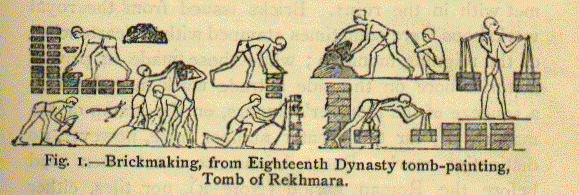Pharaoh, Haman, bricks of mud and the tower of Babel!?!
Wait a second! The Quran mentions Pharaoh, Haman, and the Tower of Babel in the same story! And contradicts known history on how the Egyptions made their bricks? "The ordinary Egyptian brick is a mere oblong block of mud mixed with chopped
Pharaoh and Haman, and their hosts were sinners ... And Pharaoh said, "Council, I know not that you have any god but me. Kindle me, Haman, a fire upon the clay, and make me a tower, that I may mount up to Moses' god; for I think that he is one of the liars." [Sura 28:8,38]
Pharaoh said, "Haman, build for me a tower, that haply so I may reach the cords, the cords of the heavens, and look upon Moses' God; for I think that he is a liar." [Sura 40:36-37]
This is another possible example of two historical compressions in the same story and the same confusion in both texts that recount the event. At least in this case, the Qur'an is consistent within itself.
According to Surah 28:35-42 and 40:36-37, Haman was a minister or official of the Pharoah (king of Egypt) who lived in the same time as Moses. According to Jewish history Haman served as the minister of Ahasuerus (king of Persia, Xerxes I is his name in Greek). Apart from the error in location, this is placing Pharaoh (Moses) and Haman in the same story even though they lived 1,000 years apart. [See Esther 3:1.]
Furthermore, in the Qur'an Haman is ordered by Pharaoh to build a tower reaching into heaven ("the Tower of Babel") which is a well known story of an event that took place long before Abraham, who lived at least 400 years before Moses. [See Genesis 11:1-9, especially the verses 3-4, "Let us build make bricks and bake them thoroughly. ... and build a ... tower that reaches to the heavens."]
This connection is confirmed through another piece of historical, archaeological evidence.
Sura 28:38 tells us: And Pharaoh said: O chiefs! I know not that ye have a god other than me, so kindle for me (a fire), O Haman, to bake the mud; and set up for me a lofty tower in order that I may survey the god of Moses; and lo! I deem him of the liars.
The Egyptians constructed their public buildings with cut stone, not bricks. The Mesopotamians, by comparison, constructed most of their public buildings with baked bricks since they lacked a good source of cut stone.
However, the Qur'an makes an historical error when it claims that the Egyptians used baked bricks. Except for some minor ruins at Nebesheh and Defenneh, baked [or burnt] bricks were not used in Egypt before the Roman period (Manual of Egyptian Archaeology, G. Maspero, H. Grevel, p. 4).
The Bible tells us in Exodus 5:6-7 :
That same day Pharaoh gave this order to the slave drivers and foremen in charge of the people: "You are no longer to supply the people with straw for making bricks; let them go and gather their own straw.
Archaeologists and historians agree:
straw and a little sand, and dried in the sun ... one man is told to break up
the ground; others carry the clods, and pile them in a heap, while others again
mix them with water, knead the clay with their feet, and reduce it to a
homogeneous paste. This paste, when sufficiently worked, is pressed by the head
workman in moulds made of hard wood, while an assistant carries away the bricks
as fast as they are shaped, and lays them out in rows a little distance apart,
to dry in the sun." (Ibid., p. 3)

This illustration is from an 18th Dynasty tomb painting, found in the Tomb of Rekhmara. It shows the process by which bricks were made in ancient Egypt.
Source: "answering islam"

No comments:
Post a Comment